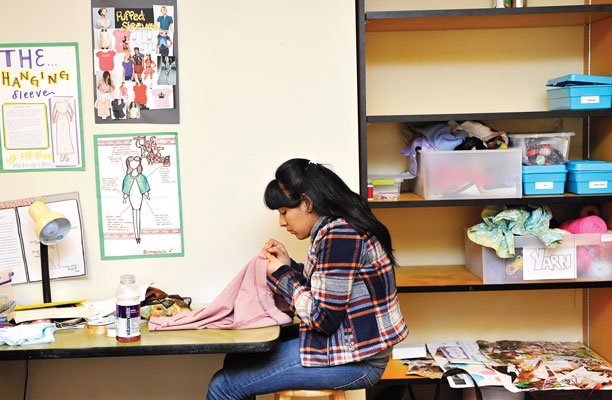Thriftiness with a sewing machine isn’t passe at Gilroy High
School, where students practice home economics for the 21st century
with an emphasis on the prefix
”
eco.
”
Thriftiness with a sewing machine isn’t passe at Gilroy High School, where students practice home economics for the 21st century with an emphasis on the prefix “eco.”
In today’s business climate, the fashion industry being no exception, “sustainable,” “eco-friendly,” “pre-loved,” “renewed vintage” and “consignment” are progressive fads fueled by a skyrocketing vogue for wearing your environmental consciousness proudly.
Gayle Vinyard’s Fashion Design and History class is tapping into this trend by creating earth-friendly threads. The course has been available since the 2009-10 school year, but the eco-element was incorporated into the curriculum in January 2011.
The class follows the “eco-friendly” philosophy of leaving as little impact on the environment as possible – in this case working with clothes that have already been manufactured instead of purchasing brand new fabrics.
“The previous apparel has already made the carbon footprint,” said the instructor who studied at the Art Institute of Chicago and has been working at GHS for six years.
Holding up an old jean jacket with a patch stitched into the fabric that read “save our earth” in colorful thread, Vinyard said “we’re working with what we’ve got.”
In addition dreaming up cute digs, the course’s concept offers students a concrete grip on legitimate careers that aren’t out of reach, making it more real for them, Vinyard said.
Participants get a full rundown on how their discipline could translate to an occupation in the fashion industry ranging from designer to multiple positions in sales, advertising and marketing.
“I like to bring out my own ideas,” said senior Abigail Enriquez, 18, who enjoys “turning something old into something new.”
Enriquez was working on an attractive vest – its delicate satin lining juxtaposed by a zipper going straight up the back to impart subtle edginess.
“I’m going to put a bow on it,” she said, holding up the one-of-a-kind style statement and eyeing her work.
The bulk of Enriquez’s material came from a dress made by Volcom – a popular surf/skate clothing brand that’s anything but cheap purchased off the rack.
When the class initially kicked off in 2009, Vinyard said 90 students including some young men signed up.
“We did have a couple boys here, but they were hunting,” she laughed, admitting she did the same thing in college by purposely taking an engineer class.
Her course was recently A-G certified in March, meaning it’s been recognized as arming students with essential skills for college and a career. Vinyard pointed out all students must take a certain number of A-G certified classes.
Showing off a brand name mock-up printed in green font that read “Elan,” Vinyard explained original plans for the eco-clothing line included selling their products in an on-campus store.
Funding cuts, however, will see Vinyard transferred to Christopher High School next year where she’ll teach painting and drawing. As for the FD&H class and its eco-friendly clothing line continuing at CHS, the possibility remains uncertain.
Vinyard said she would hate to see the class go.
“I’m worried about starting over with another principal whose eyes glaze over when I say ‘fashion.’ I’ll start on Perales,” she laughed, referring to CHS Principal John Perales.
Standing in the corner and observing students hunched over sewing machines or sifting through containers filled with colorful buttons, Vinyard said the eco-fashion concept has roped more girls into art. Some may not be the best illustrators, drawers or writers, “but they can create.”
A handful of other projects included a nautical baby doll top with gold buttons, a re-envisioned men’s collared shirt with the sleeves cut off, a colorful scarf turned into a flowing strapless top and a polka-dotted dress with turquoise buttons, red lace on the bottom trim and a black bow in the back. “An old grandma skirt” transformed into a sleek, high-waist pencil skirt – similar to what Joan from the 1960s-based TV series “Mad Men” would wear – was also on display.
“Some of these girls are like, a size zero, so they can get away with this,” chuckled Vineyard as she sifted through a rack of hangers and came to a petite, pink-striped tube top. Hanging on the wall directly above her head was a collage titled “Puff Sleeves Timeline.”
“I sew at home. It’s a lot cheaper,” said senior Nicole Gonzales, 18. “It’s the new trend, pretty much.”
Gonzales was measuring her partner Ashlie Casis, 18, a senior who said she was starting to sew on her own but has taken things further thanks to Vinyard’s instruction.
Proudly showing off an old army sergeant’s coat reworked into an avant-garde statement with crisscrossing gold brocade adorning the front, Vinyard said the peripheral skills her students develop serve practical and vocational purposes.
“I was able to fix a pair of pants that didn’t fit,” said Jazmin Osuna, a 16-year-old junior who sported bright pink acrylic nails with sparkles on them. “I did it, and it fit.”
Vinyard said materials come from thrift stores, the forgotten crevices of closets or students “steal it from their sister.”
When they run out of money to buy more supplies, Vineyard admitted she’ll sometimes “whip out” her checkbook, like the time she purchased 80 jeans jackets from the Salvation Army on half-priced Tuesday.
Her husband did complain about that a little, remembered Vinyard, who said she would consider teaching the class for free if that’s what it came down to.
“They have a lot of hopes and dreams,” she said, of her students. “There’s no end to what they can think of. There are so many ideas. It’s so fresh.”














